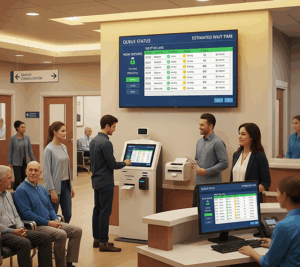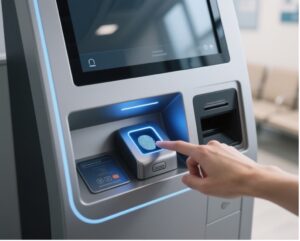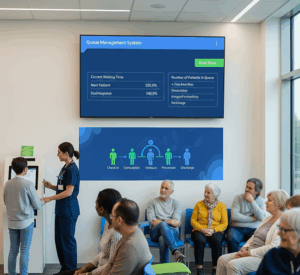
News & Updates

How ATT’s Q’SOFT® Is Redefining Queue Management for Government Agencies in 2025
Government agencies face unprecedented service delivery challenges in 2025, with rising citizen expectations for digital-first interactions and mounting pressure to optimise operational efficiency. Traditional queue management approaches simply cannot meet the demands of modern public administration, where citizens expect seamless, transparent, and responsive service experiences.
ATT’s Q’SOFT® Enterprise Queue Management System emerges as a transformative solution, specifically engineered to address the unique demands of public sector environments. This AI-powered platform replaces traditional paper-based processes with intelligent queue orchestration, delivering measurable improvements in citizen satisfaction, staff productivity, and regulatory compliance. From municipal offices to healthcare facilities and immigration centres, Q’SOFT® enables government organisations to modernise service delivery whilst maintaining the security and accountability standards required in public administration. This comprehensive analysis explores how Q’SOFT® is revolutionising government queue management, creating more efficient, transparent, and citizen-focused service experiences that align with 2025’s digital governance priorities.
Streamlined Self-Registration and Digital Check-In Systems
Government agencies are eliminating lengthy manual registration processes through Q’SOFT®’s automated self-service capabilities, fundamentally transforming how citizens interact with public services. The shift from paper-based systems to digital-first approaches represents more than technological upgrade it signifies a commitment to citizen-centric service delivery. Citizens can now complete check-ins via mobile apps, kiosks, or online platforms before arriving at government offices, significantly reducing administrative overhead and wait times. This transformation proves particularly valuable in high-volume environments where traditional manual processes create operational bottlenecks and citizen frustration.
The impact extends beyond simple efficiency gains, addressing fundamental challenges in public service delivery. Government departments report substantial reductions in processing times, improved data accuracy, and enhanced staff satisfaction as employees can focus on higher-value citizen interactions rather than repetitive administrative tasks. This digital-first approach particularly benefits high-volume facilities like passport offices, tax centres, and municipal service counters where traditional paper-based systems create bottlenecks. The streamlined processes also support better resource planning, enabling government managers to allocate staff more effectively and reduce operational costs whilst maintaining superior service quality.
Mobile-First Citizen Engagement
Q’SOFT®’s mobile platform allows citizens to join queues remotely and receive real-time updates about their appointment status, fundamentally changing expectations around government service accessibility. This capability proves especially valuable for working citizens who cannot afford to spend hours waiting in government offices. The system provides accurate wait time estimates, enabling citizens to arrive at optimal times and complete their business efficiently. Government agencies report up to 40% reduction in physical waiting room congestion, enabling better social distancing and improved facility management.
Citizens appreciate the transparency and flexibility, leading to higher satisfaction scores in public service delivery assessments. The mobile-first approach also supports vulnerable populations, including elderly citizens and those with mobility challenges, who can minimise time spent in government facilities. Real-time notifications ensure citizens stay informed about any delays or changes, building trust through transparent communication and demonstrating government commitment to respecting citizens’ time.
Multi-Language Support for Diverse Populations
Public sector environments serve diverse populations requiring multilingual support, and Q’SOFT® addresses this critical need through comprehensive language accessibility features. The system provides configurable language options across all touchpoints, ensuring accessibility for non-native speakers and vulnerable populations who might otherwise struggle to navigate government services. This capability proves essential for immigration offices, social services departments, and community health centres serving multicultural constituencies.
The multilingual functionality extends beyond basic translation, incorporating culturally appropriate interfaces and communication styles that respect diverse community needs. Government agencies using Q’SOFT® report improved service completion rates among non-English speaking populations and reduced instances of miscommunication or incomplete transactions. This inclusive approach supports government commitments to equitable service delivery whilst reducing the need for interpreter services and associated costs.
Enhanced Resource Allocation for Public Service Efficiency
Government departments struggle with unpredictable service demand and limited staffing resources, challenges that Q’SOFT®’s AI-driven analytics address through sophisticated predictive capabilities. The system analyses historical patterns, seasonal trends, and real-time data to provide actionable insights that help public administrators allocate personnel more effectively. This intelligent approach reduces idle time during low-demand periods and prevents service bottlenecks during peak hours, ensuring consistent service quality regardless of demand fluctuations. The result is a more responsive and efficient public service delivery model that maximises value from taxpayer investments in government operations.
Resource optimisation through Q’SOFT® extends beyond staff scheduling to encompass facility management, equipment allocation, and service capacity planning. Government managers gain visibility into operational patterns that were previously invisible, enabling data-driven decisions about everything from office layouts to service offerings. This intelligent resource management directly translates to cost savings and improved citizen service levels across all government touchpoints, supporting fiscal responsibility whilst enhancing public service quality. The comprehensive approach ensures that efficiency gains are sustainable and aligned with long-term operational goals.
Predictive Staffing Models
Historical data analysis enables government managers to anticipate busy periods and adjust staffing accordingly, moving beyond reactive management to proactive resource planning. Q’SOFT®’s algorithms identify patterns in citizen visits, seasonal variations, and special event impacts, helping agencies optimise counter operations and reduce overtime costs. The system considers factors such as school holidays, tax deadlines, and local events that influence service demand, enabling managers to prepare appropriate staffing levels in advance.
Municipal offices using these predictive models report 25% improvement in staff utilisation rates whilst maintaining consistent service quality throughout varying demand cycles. The predictive capabilities also support better work-life balance for government employees, as accurate forecasting reduces last-minute overtime requirements and enables more stable scheduling.
This approach contributes to improved employee satisfaction and reduced turnover, creating positive outcomes for both staff and citizens.
Cross-Department Integration
Q’SOFT® facilitates seamless coordination between different government departments, allowing citizens to complete multiple services in a single visit and reducing the bureaucratic complexity that often frustrates public service users. This integrated approach eliminates the need for citizens to visit multiple locations or repeat information across different departments, significantly improving the overall service experience. The system maintains secure data sharing protocols whilst enabling authorised staff to access relevant citizen information across connected services.
This integration reduces redundancy, improves data accuracy, and enhances overall operational efficiency across interconnected public services. Citizens benefit from shorter total service times and reduced administrative burden, whilst government departments achieve better coordination and reduced duplication of effort. The cross-department capabilities support whole-of-government service delivery approaches that are increasingly important in modern public administration.
Real-Time Performance Monitoring
Supervisors access live dashboards showing queue lengths, service times, and citizen satisfaction metrics across all service points, enabling immediate responses to emerging operational challenges. This real-time visibility supports proactive management decisions, ensuring consistent service delivery even when unexpected issues arise. The monitoring capabilities extend beyond basic queue metrics to include staff performance indicators, system utilisation rates, and citizen feedback trends.
The immediate visibility enables rapid response to operational challenges in government facilities, whether addressing staffing shortages, technical issues, or unusually high demand. Supervisors can redistribute resources, open additional service points, or implement contingency procedures based on real-time data rather than intuition or delayed reports. This responsive approach minimises service disruptions and maintains citizen satisfaction even during challenging operational conditions.
Robust Security and Compliance Features for Public Sector Requirements
Government agencies operate under strict regulatory frameworks requiring comprehensive audit trails, data protection, and citizen privacy safeguards that far exceed private sector requirements. Q’SOFT® incorporates enterprise-grade security protocols and compliance features specifically designed to meet public sector standards, including ISO/IEC 27001 certification and GDPR compliance. These built-in safeguards ensure government organisations can modernise service delivery without compromising security or regulatory adherence, addressing one of the primary concerns that often delays digital transformation in public sector environments.
The comprehensive security framework extends beyond technical protections to encompass operational procedures, staff access controls, and incident response capabilities that meet government security standards. Q’SOFT® provides the documentation and audit capabilities required for security assessments and compliance reviews, reducing the administrative burden on government IT departments. These features enable government agencies to embrace digital innovation whilst maintaining the trust and accountability that citizens expect from public institutions, creating a foundation for sustainable digital transformation in government services.
Digital Audit Trails and Accountability
Every citizen interaction generates comprehensive digital records, creating transparent audit trails for regulatory reviews and public accountability requirements that are essential in government operations. The system captures detailed information about service transactions, staff interactions, and system access, providing complete visibility into operational activities. Government agencies can demonstrate compliance with service level agreements and respond quickly to citizen inquiries or formal complaints with accurate, timestamped documentation.
These detailed logs support evidence-based policy decisions and continuous service improvement initiatives, enabling government managers to identify trends, validate service changes, and demonstrate operational effectiveness. The audit capabilities also support performance management and training needs identification, helping government departments maintain high service standards. The comprehensive documentation reduces legal and regulatory risks whilst providing the transparency that supports public trust in government operations.
Secure Data Management
Q’SOFT® employs advanced encryption and access controls to protect sensitive citizen information throughout the service delivery process, recognising that government agencies handle some of the most sensitive personal data in society. The system implements multi-layered security protocols that protect data in transit, at rest, and during processing, ensuring citizen information remains secure at all times. Role-based permissions ensure only authorised personnel can access specific data types, maintaining confidentiality whilst enabling efficient service coordination across government departments and agencies.
The secure data management capabilities extend to backup and recovery procedures, ensuring business continuity and data protection even in emergency situations. Government agencies benefit from security features that meet or exceed regulatory requirements whilst supporting operational efficiency. The system provides detailed security reporting and monitoring capabilities that help government IT departments maintain security awareness and respond quickly to potential threats or vulnerabilities.
Citizen Experience Optimisation Through Intelligent Queue Management
Modern citizens expect government services to match private sector digital experiences, bringing consumer-grade expectations to public service interactions. Q’SOFT® delivers this expectation through personalised service journeys, real-time communication, and transparent wait time estimates that transform traditional government service paradigms. The system recognises that citizen satisfaction directly impacts public trust in government effectiveness, making service experience optimisation a strategic priority for public administrators. Citizens no longer tolerate opaque processes or unpredictable service delivery, demanding the same level of transparency and efficiency they receive from commercial service providers.
Government agencies using Q’SOFT® report significant improvements in citizen satisfaction scores and reduced complaints about service delays, contributing to enhanced public trust in government efficiency. The intelligent queue management capabilities ensure that citizens feel valued and respected throughout their interactions with government services. This citizen-centric approach supports broader government objectives around public engagement and democratic participation, demonstrating that efficient service delivery contributes to stronger citizen-government relationships and improved public sector reputation.
Transparent Communication Systems
Citizens receive automatic SMS and app notifications about queue status, expected wait times, and service updates, eliminating the uncertainty and frustration that traditionally characterise government service experiences. This proactive communication demonstrates respect for citizens’ time whilst enabling better planning for both personal and business activities. The notification system provides accurate, real-time information that citizens can trust, building confidence in government service delivery capabilities.
Government offices report decreased walkaway rates and higher completion rates for scheduled appointments using these notification systems, indicating that transparent communication directly improves service effectiveness. Citizens appreciate being kept informed about delays or changes, viewing this transparency as evidence of government professionalism and consideration. The communication systems also reduce call volumes to government offices, as citizens receive updates automatically rather than calling for status information.
Accessibility Features for All Citizens
Q’SOFT® includes specialised features for elderly citizens, individuals with disabilities, and those requiring assistance, ensuring that digital transformation does not create barriers for vulnerable populations. Priority queuing systems accommodate citizens with special needs, whilst audio announcements and simplified interfaces provide alternative access methods for those who cannot use standard digital interfaces. The system supports government commitments to inclusive service delivery and compliance with accessibility legislation.
The accessibility features extend beyond basic compliance to create genuinely inclusive service experiences that welcome all citizens regardless of their technical abilities or physical capabilities. Government agencies report improved satisfaction scores among elderly and disabled citizens, indicating that thoughtful accessibility design enhances rather than compromises service quality. These features demonstrate government commitment to serving all citizens equally whilst supporting broader social inclusion objectives.
Feedback Collection and Service Improvement
Integrated feedback systems capture citizen opinions immediately after service completion, providing government agencies with actionable insights for continuous improvement that support evidence-based service enhancement. The real-time feedback collection eliminates the delay between service delivery and improvement opportunities, enabling rapid response to emerging issues or citizen concerns. Citizens appreciate having their voices heard and seeing tangible responses to their suggestions, reinforcing their engagement with government services.
This real-time feedback loop helps identify service gaps and validates improvement initiatives, supporting data-driven public service enhancement that demonstrates government responsiveness to citizen needs. The feedback data provides objective evidence for service changes and resource allocation decisions, helping government managers justify improvements and demonstrate accountability to stakeholders. The systematic approach to feedback collection and response builds trust through demonstrated commitment to continuous improvement.
Data-Driven Decision Making for Government Operations
Q’SOFT® transforms government service delivery through comprehensive analytics and reporting capabilities that support evidence-based policy decisions and operational improvements. Public administrators gain access to detailed insights about citizen service patterns, operational efficiency metrics, and resource utilisation trends that were previously unavailable or difficult to analyse. This data-driven approach enables government agencies to move beyond anecdotal evidence and intuitive decision-making to embrace objective, measurable approaches to service improvement. The analytics capabilities provide the foundation for strategic planning, budget justification, and performance management that supports effective public administration.
The comprehensive data collection and analysis capabilities ensure that government decisions are grounded in accurate, current information about citizen needs and operational performance. This analytical foundation supports transparency and accountability in government operations, enabling public administrators to demonstrate the effectiveness of their decisions and investments. This data-driven approach enables government agencies to justify budget allocations, optimise service offerings, and demonstrate accountability to stakeholders and taxpayers, creating a more professional and effective public service delivery model that serves citizen interests more effectively.
Performance Analytics and KPI Tracking
Government managers can monitor key performance indicators including average service times, citizen satisfaction rates, and staff productivity metrics through comprehensive dashboards that provide both real-time and historical perspectives. Custom reporting capabilities support budget planning, performance reviews, and strategic planning initiatives, enabling evidence-based management decisions. The analytics provide objective measures of service quality and operational efficiency that support continuous improvement efforts and demonstrate government effectiveness to stakeholders.
These analytics help justify investments in digital transformation and demonstrate tangible improvements in public service delivery to elected officials, oversight bodies, and citizens. The performance tracking capabilities support staff development and recognition programmes, whilst identifying areas where additional training or resources may be needed. Government agencies can benchmark their performance against service standards and demonstrate compliance with public service commitments through objective measurement and reporting.
Operational Optimisation Insights
Historical data analysis reveals patterns in citizen behaviour, peak service times, and seasonal demand fluctuations that enable strategic operational planning and resource allocation. Government agencies use these insights to optimise facility layouts, adjust operating hours, and plan capacity expansions based on objective evidence rather than assumptions. The analytical capabilities support long-term strategic planning by identifying trends and patterns that inform infrastructure investments and service development initiatives.
This strategic approach ensures public resources are allocated efficiently whilst meeting citizen needs effectively, supporting fiscal responsibility and service quality objectives simultaneously. The operational insights enable government agencies to anticipate and prepare for demand changes, ensuring consistent service quality throughout varying operational conditions. The data-driven approach to operational optimisation demonstrates professional management practices that build stakeholder confidence in government effectiveness and stewardship of public resources.
Q’SOFT® represents a paradigm shift for government agencies seeking to modernise citizen services whilst maintaining security, compliance, and accountability standards that are essential in public administration. By combining AI-powered queue management with robust analytics and citizen-focused features, ATT enables public sector organisations to deliver efficient, transparent, and accessible services that meet 2025’s digital governance expectations. The comprehensive solution addresses the unique challenges of government service delivery, from regulatory compliance to citizen accessibility, whilst providing the operational efficiency and cost-effectiveness that taxpayers expect. Government agencies ready to transform their service delivery can explore Q’SOFT®’s capabilities and join the digital government revolution that is reshaping public service delivery across the globe. The future of government services lies in intelligent, citizen-centric systems that respect both operational requirements and citizen expectations, and Q’SOFT® provides the proven foundation for this transformation.
Contact ATT at infosoft-sales@attsystemsgroup.com for details.
Frequently Asked Questions
Q: How does ATT’s Q’SOFT® improve wait times and reduce congestion in government offices?
A: Q’SOFT® enables remote queue joining, digital check-ins, and real-time updates, which help reduce physical waiting room congestion by up to 40% and streamline citizen flow.
Q: In what ways does Q’SOFT® support multilingual populations in public service environments?
A: The platform offers configurable multi-language options and culturally sensitive interfaces, making services accessible to non-native speakers and improving completion rates for diverse communities.
Q: What security measures does Q’SOFT® provide to ensure data protection for government agencies?
A: Q’SOFT® features enterprise-grade encryption, role-based access controls, and digital audit trails, meeting ISO/IEC 27001 and GDPR standards for public sector compliance.
Q: Can Q’SOFT® help government managers optimise staffing and resources during peak demand periods?
A: Yes, its AI-driven predictive analytics allow managers to anticipate busy times, adjust staffing, and allocate resources proactively, improving service efficiency and reducing costs.
Q: How does ATT’s Q’SOFT® enhance citizen satisfaction compared to traditional queue management systems?
A: Q’SOFT® provides transparent wait time estimates, real-time notifications, and accessible self-service features, leading to higher satisfaction scores and fewer complaints.
Q: What integration capabilities does Q’SOFT® offer for cross-department government services?
A: Q’SOFT® enables secure sharing of citizen information across departments, allowing multiple services to be completed in one visit and reducing redundancy and bureaucracy.
Q: Is Q’SOFT® suitable for elderly citizens or those with disabilities?
A: Absolutely; it includes priority queuing, audio announcements, and simplified interfaces, ensuring inclusive access for all citizens regardless of ability.
Contact ATT at infosoft-sales@attsystemsgroup.com for details.
Send us a message
Contact Information
Address:
35 Ubi Crescent, ATT Building, Singapore, 408585
Phone:
Email:
Website:
www.attsystemsgroup.com






